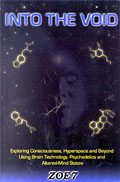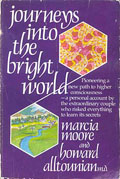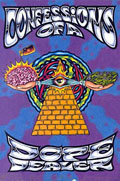The Void, the Bright, and the Confessions
Recommendations for Autobiographies from Hyperspace
Nov 2011
Citation: Fork. "The Void, the Bright, and the Confessions: Recommendations for Autobiographies from Hyperspace". Erowid Extracts. Nov 2011;21:18-19. Online edition: Erowid.org/library/review/review_article6.shtml
I love autobiographies. Budding writers are told, "write what you know", and few things fit that advice better than writing one's own story. Inject a healthy dose of psychedelic use, and I'm hooked. Within the genre of psychoactive drug literature, there are several first-person tales from explorers of hyperspace that I've repeatedly reread. These are three of my favorites.
Much of Zoe Seven's Into the Void ought to be taken with a grain of salt. Beyond the misguided, unbelievable, and hilarious disclaimer and the author's consistent misuse of words, one still has to deal with his proclivity for sweeping generalizations and New Age beliefs. Seven claims to be a "multi-dimensional synergy-personality cluster" comprised of himself and the consciousnesses of five other people who exist in alternate dimensions. (I know, it doesn't add up. But he has special math to explain it!) Yet if one can overlook such warts, and stomach Seven's melodramatic delivery and penchant for conspiracy theories, this book contains a great deal of novel, thought-provoking material. Although Seven is forthright about his lack of formal education, his experiments mapping and targeting particular brain states evidence a curious and intelligent individual.
Seven is obsessed with altered states, their spiritual/philosophical implications, and the importance of first-hand experience. His fascination leads him to investigate paranormal realms (out-of-body experiences, remote viewing, telepathy), lucid dreaming, electronic "mind machines", and--eventually--psychedelics. Although Seven was 31 when he began experimenting with drugs, many of his trips feature over-the-counter medications that are more popular among teens: dextromethorphan (cough medicine), dimenhydrinate (Dramamine), cyclizine (Marezine), and diphenhydramine (Benadryl). He goes on to make up for lost time, intrepidly logging countless voyages in only a few years, and carefully recording his experiences.
Since the 1960s, it has been fashionable to characterize the effects of psychedelics within the context of Eastern spirituality. More recently, the lil' darlin' of entheo-explanation has been theoretical quantum physics, which Seven uses to make sense of his visions. Although I am suspicious of autodidacts' explanations of ultra-technical ideas, Seven weaves an intriguing tale filled with fun-to-consider possibilities. When I first read this book a decade ago, I'd never had the sort of "true hallucinations" that he describes. However, since then, my experiments with ketamine and nitrous oxide have yielded these sorts of visions, as well as serial trips, similar to Seven's, that appear to be an "other-dimensional me" attempting to communicate with the "this-dimensional me". As a result, Seven's ideas about parallel Earths and "psychoporting" into the physical bodies of individuals in alternate realities are now even more intriguing to me.
Seven's descriptions of the effects of using mind machines while on assorted psychoactives are unique to the psychedelic literature. These alone make the book worth reading. Over the course of his tale, Seven reveals himself to be a likeable character--flawed, as we all are, but inspiring in his honest exuberance. Into The Void presents flavors along the lines of many reports posted in Erowid's Experience Vaults: raw, foolhardy, insightful, and motivated by a desire to better know one's self and the universe.
Long before the Shulgins' alphabetamine love stories appeared on bookstore shelves, Marcia Moore and Howard Alltounian gave us Journeys Into the Bright World, a drug travelogue focused on the transpersonal effects of ketamine. As with Into the Void, there's a strong woo-woo vibe: Moore was a New Age author-lecturer. I initially wondered how Alltounian, a doctor trained in Western medicine, so comfortably embraced his wife's paranormal views. Yet as I continued to read, Moore's interpretation of ketamine's effects within her belief structure--embracing past lives, archetypes, the Tarot, and assorted psychic phenomena--never seemed to bother me. Without proselytizing, she simply describes the ketamine experience from the perspective of her own ideological framework.
Moore presents sincere, detailed accounts of the wide range of ketamine's psychological effects. She points out the important role that music can have in directing a K session, she waxes poetic on its effect on language, and she eventually comes to feel that ketamine allows users to access internal dualistic sub-personalities that unconsciously affect one's daily choices.
Moore is clearly the main author of the text and the primary champion of ketamine. Alltounian's contributions take the form of transcriptions from tape recordings that he made during his K voyages with Moore. Writing a book about their "bright world" forced the pair to face the possible negative consequences that advocating drug-inspired spiritual insights might have on their established careers. Yet the benefits they believed the world-at-large might gain ultimately compelled them to publish their findings. Unfortunately, as the tale unfolds, hints are dropped that Moore's ketamine use is becoming problematic. Near the book's conclusion, Moore is told to stay away from ketamine by John Lilly, the infamous scientist who researched floatation tanks and dolphins. Lilly had acquired his own ketamine monkey; his advice should have been heeded. However, Moore seems to have succumbed to addiction.
In a tragic end to this story, a year after publication, Moore became one of the few ketamine-related fatalities on record. Apparently, in an attempt to hide her ketamine use from her increasingly concerned husband, she went outside on a freezing-cold night, climbed into a tree, and after a number of injections, ended up dying from exposure. Her skeleton was found over two years later. After that, Alltounian's view of ketamine became darker, and Moore's children have demanded that Erowid take down a PDF of the book. Journeys Into the Bright World may be viewed as the cautionary tale from a more naïve time in the history of this fascinating yet problematic psychoactive drug.
Confessions of a Dope Dealer is the coming-of-age story of Sheldon Norberg. As a bright young suburban kid, Norberg held a typical anti-drug attitude until his early teenage years, when his eldest brother Dave admitted to smoking pot and dropping acid. Initially shocked, Sheldon soon starts experimenting. He discovers a whole new world when visiting Dave at UC Berkeley's Barrington Hall, an infamous student housing co-op steeped in hippie culture.
At age 13, Norberg moves to Roseville, California, a painfully unhip city near Sacramento, where he befriends the local stoners and realizes the potential of his dope connections in the San Francisco Bay Area. Regular trips to Berkeley keep him and his new buddies in the green: high-quality bud and fat stacks.
Recalling my own childhood while reading this book, I could often relate to Norberg's struggles as he grew into a young man: grappling with sexual desire and female relationships, rebelling against parents ("Mom found my stash!"), and developing patterns of problematic drug use. Although he goes to college, he's more interested in partying and dealing drugs than attending classes, and he sees himself as a kind of psychedelic guru for those around him. Norberg recounts his life in thorough and sometimes unflattering detail; multitudes of people are introduced throughout the book as he describes what seems like every individual he ever met. He eventually drops out of school, becomes an outdoor pot grower, and spends his free time following the Grateful Dead.
Norberg's humor kept me turning pages, eager to see what would happen to him next. My sole criticism of Confessions is that it features an overabundance of characters, making it hard to remember who is who at times. But maybe I was just too stoned.

|
Into the Void #
by Zoe Seven (Zon Worldwide Media, 2001)Much of Zoe Seven's Into the Void ought to be taken with a grain of salt. Beyond the misguided, unbelievable, and hilarious disclaimer and the author's consistent misuse of words, one still has to deal with his proclivity for sweeping generalizations and New Age beliefs. Seven claims to be a "multi-dimensional synergy-personality cluster" comprised of himself and the consciousnesses of five other people who exist in alternate dimensions. (I know, it doesn't add up. But he has special math to explain it!) Yet if one can overlook such warts, and stomach Seven's melodramatic delivery and penchant for conspiracy theories, this book contains a great deal of novel, thought-provoking material. Although Seven is forthright about his lack of formal education, his experiments mapping and targeting particular brain states evidence a curious and intelligent individual.
Seven is obsessed with altered states, their spiritual/philosophical implications, and the importance of first-hand experience.
Since the 1960s, it has been fashionable to characterize the effects of psychedelics within the context of Eastern spirituality. More recently, the lil' darlin' of entheo-explanation has been theoretical quantum physics, which Seven uses to make sense of his visions. Although I am suspicious of autodidacts' explanations of ultra-technical ideas, Seven weaves an intriguing tale filled with fun-to-consider possibilities. When I first read this book a decade ago, I'd never had the sort of "true hallucinations" that he describes. However, since then, my experiments with ketamine and nitrous oxide have yielded these sorts of visions, as well as serial trips, similar to Seven's, that appear to be an "other-dimensional me" attempting to communicate with the "this-dimensional me". As a result, Seven's ideas about parallel Earths and "psychoporting" into the physical bodies of individuals in alternate realities are now even more intriguing to me.
Seven's descriptions of the effects of using mind machines while on assorted psychoactives are unique to the psychedelic literature. These alone make the book worth reading. Over the course of his tale, Seven reveals himself to be a likeable character--flawed, as we all are, but inspiring in his honest exuberance. Into The Void presents flavors along the lines of many reports posted in Erowid's Experience Vaults: raw, foolhardy, insightful, and motivated by a desire to better know one's self and the universe.

|
Journeys Into the Bright World #
by Marcia Moore and Howard Alltounian (Para Research Inc, 1978)Long before the Shulgins' alphabetamine love stories appeared on bookstore shelves, Marcia Moore and Howard Alltounian gave us Journeys Into the Bright World, a drug travelogue focused on the transpersonal effects of ketamine. As with Into the Void, there's a strong woo-woo vibe: Moore was a New Age author-lecturer. I initially wondered how Alltounian, a doctor trained in Western medicine, so comfortably embraced his wife's paranormal views. Yet as I continued to read, Moore's interpretation of ketamine's effects within her belief structure--embracing past lives, archetypes, the Tarot, and assorted psychic phenomena--never seemed to bother me. Without proselytizing, she simply describes the ketamine experience from the perspective of her own ideological framework.
Moore presents sincere, detailed accounts of the wide range of ketamine's psychological effects. She points out the important role that music can have in directing a K session, she waxes poetic on its effect on language, and she eventually comes to feel that ketamine allows users to access internal dualistic sub-personalities that unconsciously affect one's daily choices.
Moore is clearly the main author of the text and the primary champion of ketamine. Alltounian's contributions take the form of transcriptions from tape recordings that he made during his K voyages with Moore. Writing a book about their "bright world" forced the pair to face the possible negative consequences that advocating drug-inspired spiritual insights might have on their established careers. Yet the benefits they believed the world-at-large might gain ultimately compelled them to publish their findings. Unfortunately, as the tale unfolds, hints are dropped that Moore's ketamine use is becoming problematic. Near the book's conclusion, Moore is told to stay away from ketamine by John Lilly, the infamous scientist who researched floatation tanks and dolphins. Lilly had acquired his own ketamine monkey; his advice should have been heeded. However, Moore seems to have succumbed to addiction.
In a tragic end to this story, a year after publication, Moore became one of the few ketamine-related fatalities on record. Apparently, in an attempt to hide her ketamine use from her increasingly concerned husband, she went outside on a freezing-cold night, climbed into a tree, and after a number of injections, ended up dying from exposure. Her skeleton was found over two years later. After that, Alltounian's view of ketamine became darker, and Moore's children have demanded that Erowid take down a PDF of the book. Journeys Into the Bright World may be viewed as the cautionary tale from a more naïve time in the history of this fascinating yet problematic psychoactive drug.

|
Confessions of a Dope Dealer #
by Sheldon Norberg (North Mountain Publishing, 1999/2000)Confessions of a Dope Dealer is the coming-of-age story of Sheldon Norberg. As a bright young suburban kid, Norberg held a typical anti-drug attitude until his early teenage years, when his eldest brother Dave admitted to smoking pot and dropping acid. Initially shocked, Sheldon soon starts experimenting. He discovers a whole new world when visiting Dave at UC Berkeley's Barrington Hall, an infamous student housing co-op steeped in hippie culture.
At age 13, Norberg moves to Roseville, California, a painfully unhip city near Sacramento, where he befriends the local stoners and realizes the potential of his dope connections in the San Francisco Bay Area. Regular trips to Berkeley keep him and his new buddies in the green: high-quality bud and fat stacks.
Recalling my own childhood while reading this book, I could often relate to Norberg's struggles as he grew into a young man: grappling with sexual desire and female relationships, rebelling against parents ("Mom found my stash!"), and developing patterns of problematic drug use. Although he goes to college, he's more interested in partying and dealing drugs than attending classes, and he sees himself as a kind of psychedelic guru for those around him. Norberg recounts his life in thorough and sometimes unflattering detail; multitudes of people are introduced throughout the book as he describes what seems like every individual he ever met. He eventually drops out of school, becomes an outdoor pot grower, and spends his free time following the Grateful Dead.
Norberg's humor kept me turning pages, eager to see what would happen to him next. My sole criticism of Confessions is that it features an overabundance of characters, making it hard to remember who is who at times. But maybe I was just too stoned.

